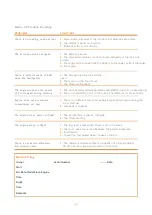
Preparing the engine for running
Always test the engine in a test bench before installing it into the plane, this will confirm that all system work as
they should, and you will be able to learn its operation and the emergency procedures. A suitable
platform/table/workbench is now required to clamp the test stand onto. Make sure this can be easily
transported outside and weight enough to ensure it cannot be blown over by the thrust of the engine.
Select a clear area for running – keep clear of areas with loose leaves, sand or other debris that could be picked
up or drawn towards the intake. Ensure the fuel tank is position well clear of the exhaust area and secured.
First engine runs
•
Confirm your test stand is securely fixed to a bench or heavy table. Keep your ear defenders within easy reach
and a CO2 fire extinguisher handy. VERY IMPORTANT ON KEROSTART ENGINES.
•
Fill the fuel tank. Do not forget to filter the fuel, and to mix the oil.
•
Confirm all batteries are freshly charged and connected up. USE ONLY 7,4V Batteries.
•
Check there is a temperature reading on the data terminal.
•
Ensure the running area is clear of onlookers – especially the prohibited zone of a 10 metre radius 180° arc from
engine centre around the rear.
•
Verify that the fuel tubes are full of fuel and purged of all air, if not, carry out the fuel prime sequence as
described here.
13
The kerostart system used on this is a reliable and well tested that produce very smooth and trouble free starts.
However, extra care and attention must be paid when starting a kerostart engine.
The main difference between gas and kerosene is that in the case of a failed ignition, the gas dissipates quickly
on the air and don't keep inside the engine. Kerosene is liquid and, if unburned, will pool inside the engine and
stay there forever. The engine can hold a big quantity of kerosene inside. This kerosene will be ignited on next
successful start up and will be pushed to the exhaust as soon as the airflow inside the engine is sufficient, and will
be ignited in the exhaust, causing a hot start (in extreme cases a big fireball) that will not hurt the engine, but can
destroy the model.
To prevent this:
-During the start-up listen to the engine sound to check for positive sound of ignition, check looking from
the exhaust that the kero is burning, or check for a increase in exhaust temperature in the data terminal. A small
plume of white smoke from the exhaust mean that the kero is not burning, so the kero is pooling inside the
engine. Abort immediately the start.
-Double check that solenoid valves are installed in the correct sense. A extra security measure is to place
a manual valve between the last fuel tank and the pump intake line, to prevent that during the process of filling
the tanks or during storage, some fuel can arrive to the engine.
-After a failed start, or whatever condition that could cause that fuel be collected inside the engine (i.e.
extra priming), ALWAYS empty the engine of fuel by tilting the engine nose down. Fuel will exit trough intake. Do
not tilt upwards, due at the internal engine construction, the fuel cannot exit trough exhaust.
Another big difference between gas start and kero start is that the kerosene can keep burning during long time
inside the engine. This situation usually happen during a aborted start, the start-up sequence is aborted by the
user or automatically before the engine arrive to idle. This can cause that the kerosene inside the engine keep
burning for long time, and could destroy the engine or the model. IF A STARTUP SEQUENCE IS NOT COMPLETED,
ALWAYS CHECK FOR FLAME INSIDE THE ENGINE. If there is flame, then set full throttle to engage the starter and
blow out the flame. USE SHORT BURSTS OF STARTER. Using the starter for long time can destroy the starter
motor. In the case that the start-up procedure has been aborted due at starter failure, then it will be necessary to
apply the CO2 fire extinguisher. A white smoke from the engine is a good indication here, mean that there is no
fire inside.
Important notes for kerostart engines.
PLEA S E READ




































